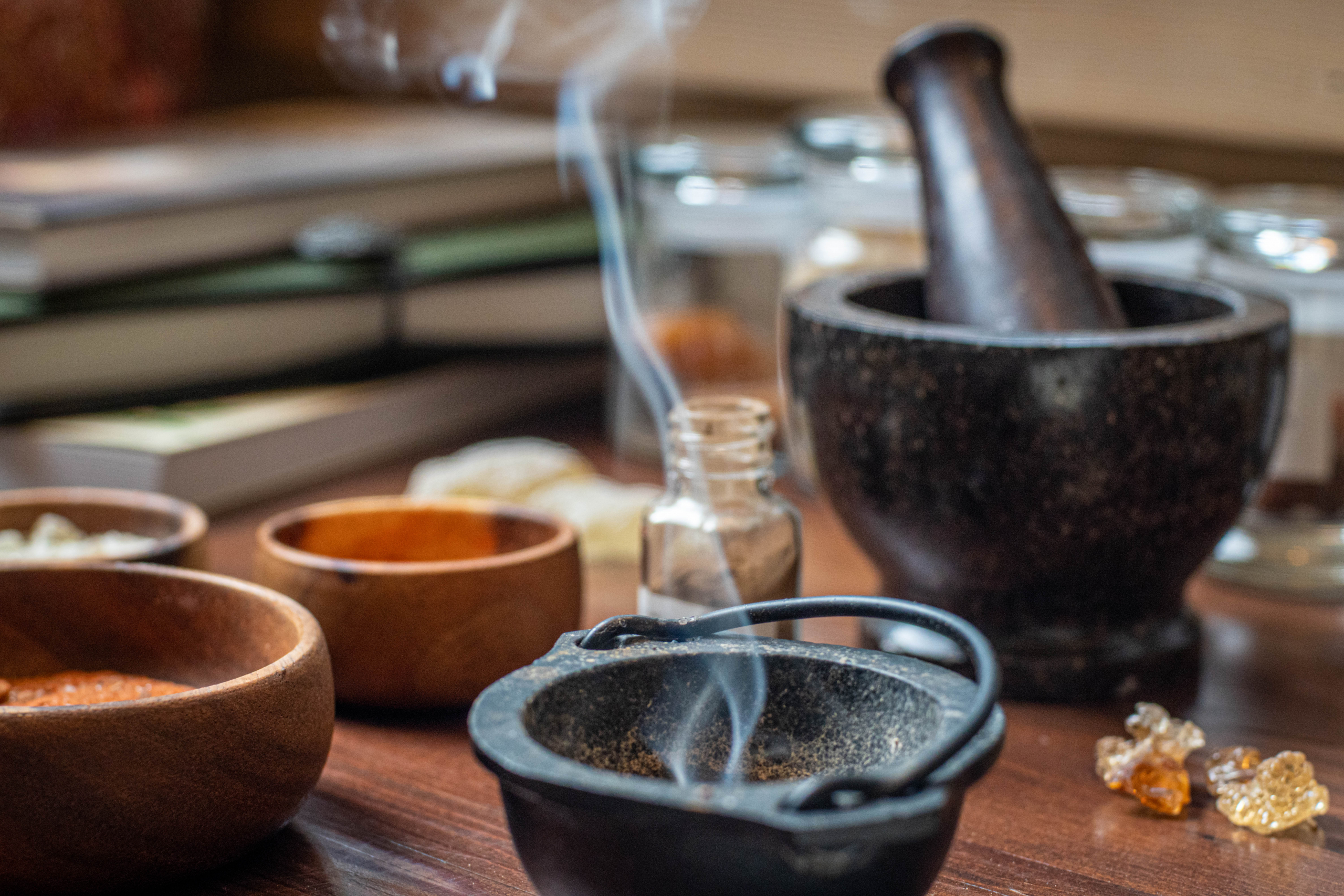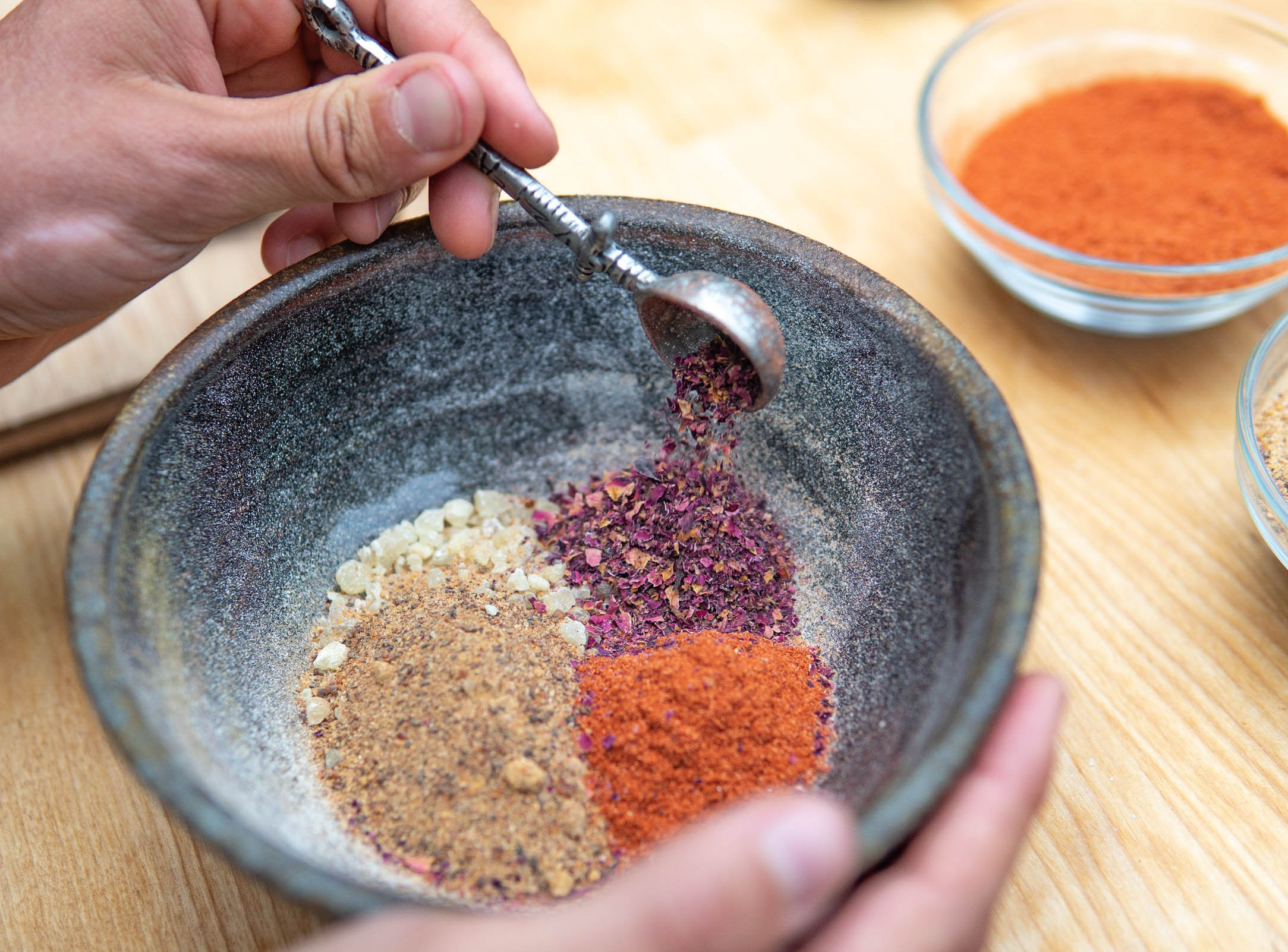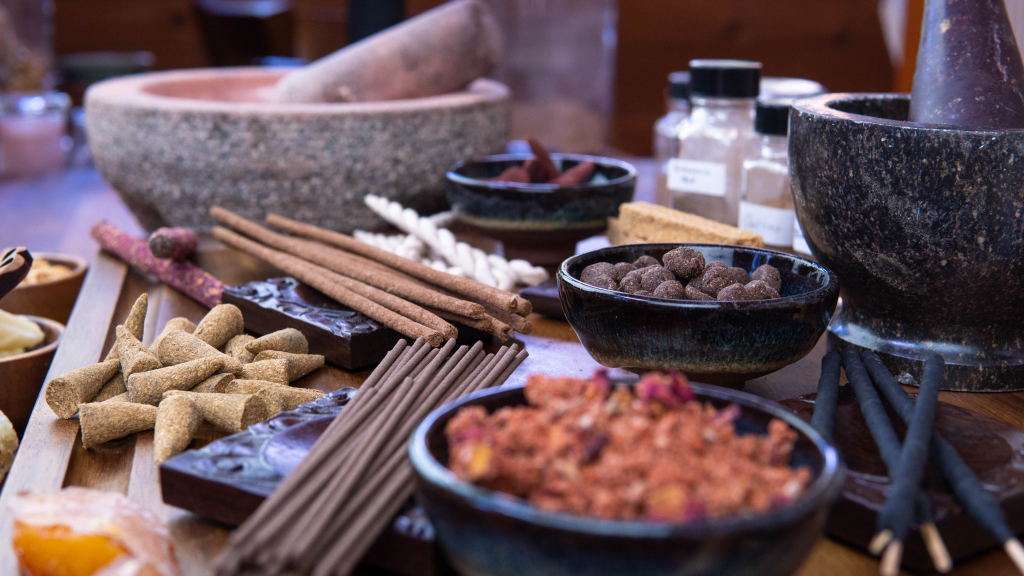
The Art of Incense Crafting
Imagine walking through the depths of the forest; it’s so quiet that all you hear are the treetops swaying from the light breeze, it smells like fresh, damp wood, and a hint of evergreen, and you finally find them - the raw aromatic plants and resins you’ve been searching for to roll into your own hand-crafted incense.
Incense crafting has long been practiced in many cultures, but has become a forgotten art in modern society - the missing link in Western herbalism, aromatherapy, and the healing arts. But what if you could connect the dots?
Incense is plant medicine that fills the air; the original aromatic medicine. It is the traditional roots of modern aromatherapy, and gave rise to all other aromatic arts. The path of incense crafting requires creativity, intuition, precision and passion, but it’s a skill that’s accessible to all. All you need is a willingness to dedicate your time and energy into cultivating it. Let’s explore a brief history of incense crafting and the potential dynamic beauty you can experience as an incense crafter.
Whether you already make your own incense and are looking for a fresh perspective or new ideas, or you’re interested in learning how to create your own incense and can envision yourself doing so, this article has something for you.

History of Incense Crafting
In many traditions around the world, incense was, and still is, an important healing technique and an intrinsic part of ritual and spiritual life. Smoke and aromatic plant medicine in the form of incense, fumigants, and infused steam has been used by ancient doctors, medicine people, healers, and shamans for centuries to bring balance to the body and emotions, clarity to the mind, and healing to the soul.
Aromatic medicine and incense use can be seen across Ancient Egypt, Native American culture, Indigenous practices, Ayurveda, and in Traditional Chinese medicine, just to name a few. Within each culture unique forms of incense were created over hundreds, even thousands of years. The combining of a region’s different native plants and tree resins coupled with the local healing and spiritual wisdom gave rise to countless exotic incenses, ranging in all forms and sizes.
Centuries ago, most incense crafters took pride in choosing their aromatic botanicals and made sure they were of the highest purity and superiority. Many incense crafters in India, China, the Middle East, and Southeast Asia still follow ancient medicinal incense recipes and try to hold true to their aromatic plant medicine traditions. And many artisan crafters still put their full passion for purity and traditional methods into their blends for pure enjoyment and exhilaration of the senses.
Unfortunately, in our modern world, filled with adulteration in the name of profit, the mainstream incense market is flooded with chemicals and cheaply made products. Now, more than ever, it’s important to reignite the traditional ways of the path of incense crafting so that the roots of this ancient art aren’t lost forever.
The Beauty of Incense Crafting
As you may already know, becoming an incense maker not only emboldens you to practice and revive an ancient craft, but it also opens many doors for you, energetically and spiritually. Being involved in every step of the process, from raw plant material to incense burning, is enlightening and uplifting, to say the least. It helps you develop a profound bond to the plants and the mystical art of aromatic medicine.

Ingredients
Learning how to make your own incense gives you the ability to choose the raw plant material and aromatic resins that you work with. It can be very empowering to control what goes into your incense and be able to guarantee that only the best quality organic plant materials are used, especially when there is often no guarantee that the incense available on today’s market is chemical-free.
When you become more familiar with different aromatic plants and how to identify them, you can take it one step further and go out into the wild and sustainably harvest your incense ingredients. Wandering through the forest to wild harvest is not only a great way to experience and form a relationship with your local natural environment, but it’s also an incredibly fun scavenger hunt! It’s a great excuse to get outside and brings purpose to your next outdoor adventure.
You might consider starting your own aromatic plant medicine garden, if it’s accessible to you, so that you can organically grow incense plant materials yourself. Interacting with fresh, living plants and nature in this way helps you connect to the energy of the plants you’re working with, which in turn, helps enhance the therapeutic and energetic benefits of your incense and medicines.
Blending
Crafting your own incense opens the doorway to creativity and intuition. Once you really dive in, you’ll not only be able to identify plants more and more, but you’ll start to get to know their energetic profiles; how they look, taste, smell, and most importantly, how they’ll blend with other plants. Once you start experimenting with different blends, you’ll be surprised at how your intuition develops to create more complex recipes. Make sure to take detailed notes every time you create a recipe to help you on your journey!
Learn How to Make Irresistible Incense For
Enjoyment, Healing & Ritual with
✨ The Art of Incense Crafting Ebook ✨
Download Your Free Copy Below

Are you ready to learn how to craft your own natural incense? This free eBook covers the essentials of creating incense that burns beautifully and smells divine, exploring its role as an ancient aromatic medicine and sacred ritual tool. Avoid common pitfalls and unlock step-by-step instructions to make incense cones with ease.
Magical Elements
To emphasize the many different esoteric and magical aspects of incense, many crafters take the timing of crafting incense into consideration. Some incense makers craft according to the seasons, equinoxes and solstices, while others consider astrology, lunar cycles, and planetary alignments. These factors can not only affect what ingredients or recipes you use, but also the time of day or location you create your incense. Many also consider it significant to be aware of what state of mind you’re in when incense crafting, since your energy can affect the energy of the plants and the resulting medicinal aromatic energetics.
Those who live in alignment with the seasons find that Autumn is one of the most magical times of year to craft incense. Summer symbolizes energy moving outward, while Autumn represents energy focused inward. The Summer is billowing with heat and full of passion, excitement, and energy, and when Autumn comes around, there’s usually more time to slow down, breathe and integrate all of the inspiration that Summertime stirred up. For many creatives, Fall is known as the time for visionary projects, which may simply be because for many, the brisk weather encourages you to stay indoors more often, or because there seems to be a certain level of magic in the air.

Main Incense Types & Their Uses
Incense comes in countless forms, ranging from smudge sticks, raw tree resins, hand-formed pellets, cones, sticks, coils, single herbs, loose incense, and so much more. Each incense type has different specific uses and offers its own unique experience and therapeutic benefits to be reveled in. There are endless variations of incense to create and each incense crafting session is an awaiting adventure.
Single Herbs/Resins
This is the most ancient form of incense, before the creation of sticks, cones, or other complex formulation processes. The most simple, and sometimes most meaningful way to burn aromatic plants is by placing a single dried herb or incense resin onto hot charcoal. This basic method allows for you to experience the many levels of aroma of a single aromatic plant in a more intimate way. Having a more solitary experience with one plant can also enhance many therapeutic benefits, on physical, emotional, and energetic levels.
Loose Incense
Loose incense is often a balanced mixture of aromatic plants, tropical hardwoods, and sticky resins. In addition to their sweet, uplifting aromas, the resins can also act as glue, helping to create a granola-like consistency, creating small chunks throughout the mixture.
This is an ancient form of incense widespread throughout nearly every culture before the invention of the stick and cone. As with single herbs and resins, loose incense is burned on hot charcoal. Each pinch of loose incense varies slightly in its aromas as it burns, creating a perpetually dynamic aromatic experience.
Incense Cones
First created by the Japanese in the 1800’s, cones are one of the easiest forms to make for beginning incense crafters. Traditionally, they are a mixture of powdered aromatic woods, resins, and other botanicals, as well as some type of natural binder or plant gum to help them hold their form.
Cones tend to provide a more noticeable, stronger fragrance because they burn faster than sticks, releasing more natural aromatic constituents into the atmosphere in a shorter timespan; whereas sticks give off a more subtle aroma for a longer period of time.

Incense Sticks
The earliest documented appearance of incense sticks was in China during the Ming Dynasty (1348-1644) [1]. They’ve become one of the most popular and common ways to burn incense.
There are two main types of incense sticks, one with a wooden stick center, called “Agarbatti”, and one without, called “Dhoop”. Agarbatti sticks are produced mostly in India and China. The bamboo stick at their core prevents them from easily breaking, but can also slightly alter the aroma.
Dhoop sticks are most commonly crafted in Japan and Tibet. They’re made by rolling an incense dough of blended powdered botanicals, a binding agent and water into long, thin incense ropes, which are then air dried and cut to size.
Sadly, in today’s mainstream market, many incense sticks and cones are made with harmful chemical fragrances and synthetic materials to cut costs. That’s why it’s always important to research where your incense is coming from or guarantee its purity by making your own.
Conclusion
Incense crafting is an ancient art that builds the pathways for you to connect with aromatic plant medicine, healing, imagination, and magic. As a crafter, you’ll begin to notice how your relationships to plant medicine and the natural world start to strengthen and expand in many directions. You’re bound to discover new creativity, insights, and inspiration as you begin, or continue down your path of this sacred art.

Want to make your own incense cones? Pick up one of our Incense Crafting Starter Kits today and be well on your way to crafting your own custom scents!
Article written by Melissa Szaro

References
Yen, M. (2021) Incense Sticks vs Cones: Everything You Need to Know. Kin. Retrieved from https://kinobjects.com/blogs/news/incense-sticks-vs-cones
© 2021 The Northwest School of Aromatic Medicine. All rights reserved.
*The statements above have not been evaluated by the FDA, and are for educational purposes only. This article is not intended to diagnose, treat, cure, or prevent any disease. This article should not be taken as medical advice. Please consult your physician before you use this information for health purposes.
